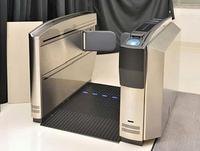-
Smart robots to advance science, perform rescue missions
Researchers see a day in the not-so-distant future when intelligent robots will be working alongside humans on a wide range of important tasks from advancing science, to performing deep sea rescues, to monitoring our natural habitats; it is a bold leap from the pre-programmed factory robots and remote-controlled drones we are most familiar with today
-
-
April 2012 Indian Ocean earthquake indicate s that a new tectonic plate is being born
The 11 April 2012 8.7 magnitude earthquake in the Indian Ocean, unlike its 2004 predecessor, did very little damage; it began at one fault, and when it reached an intersecting fault, it ruptured; in total, four different faults were ruptured over the course of 150 seconds; when earthquakes spread to connecting faults, the rupture rips along faults that branch away from the initial fault like branches of a river; the April 2012 earthquakes took a very different course, running along grid-like patterns and making 90 degree turns; the weird rupture pattern reflects the fact that the region is giving birth to a new tectonic plate
-
-
Boarding gate with built-in explosives detection speeds up airport security checks

Japanese researchers have developed a boarding gate with built-in explosives detection equipment; the gate collects minute particles which have affixed themselves to IC cards or portable devices used as boarding passes, and can detect within one or two seconds the presence of explosive compounds using internalized equipment; the developers say the gate allows the inspection of 1,200 passengers per hour
-
-
The negative effects of increasing computerized surveillance

To understand the effects of continuous computerized surveillance on individuals, Finnish researchers equipped ten Finnish households with video cameras, microphones, and logging software for personal computers, wireless networks, smartphones, TVs, and DVDs – then followed what happened
-
-
China’s infrastructure is failing owing to sub-standard materials, corruption, and lax regulation
Shoddy infrastructure in China has put people in danger time and time again; many of the infrastructure issues in China stem from the government’s focus on quantity over quality, as well as making sure that as many people are employed as possible for a project, rather than using the latest construction technology; sub-standard materials, corruption, and lax regulation only exacerbate the problem
-
-
City of Ottawa sits atop soft soil, a geologic features which amplifies seismic waves

Roughly 20 percent of the Ottawa area is built on bedrock, while the remaining area contains unconsolidated surface deposits; this is not good news for city planners – and dwellers – because soft soil amplifies seismic waves, resulting in stronger ground motion than for sites built over bedrock
-
-
Assessment reports mineralization of 2.173 million tons rare Earths elements in Idaho, Montana
U.S. Rare Earths, Inc. announced the other day the final results of an independent analysis of historic exploration work done on its Idaho and Montana properties
-
-
Innovative, “complete” solution for oil-spill cleanup
Corncobs, straw, and other absorbents used to clean up oil spills can hold only about five times their own weight and pick up water, as well as oil; scientists describe what may be a “complete solution” to cleaning up oil spills — a superabsorbent material that sops up forty times its own weight in oil and then can be shipped to an oil refinery and processed to recover the oil
-
-
Center for Security Studies receives $3 million grant
Officials at the Texas Tech University System and Angelo State University (ASU) announced that the U.S. Air Force will provide a $3 million grant to ASU which will be used to continue and expand the school’s Center for Security Studies (CSS)
-
-
Non-lethal cures: new antibiotic cures disease by disarming pathogens, not killing them
A new type of antibiotic can effectively treat an antibiotic-resistant infection by disarming instead of killing the bacteria that cause it; this is good news, since new drugs are badly needed for treating infections with the bacterium Acinetobacter baumannii, a pathogen that most often strikes hospital patients and immune- compromised individuals through open wounds, breathing tubes, or catheters
-
-
The Western hemisphere’s largest seawater desalination plant to be built in California

The San Diego County Water Authority announced plans to build the Western hemisphere’s largest seawater desalination plant; the plant will produce fifty million gallons of fresh water per day, enough to supply about 7 percent of the San Diego region in 2020
-
-
New study tracks long-term sea-level rise
Greenhouse gas emissions up to now have triggered an irreversible warming of the Earth which will cause sea-levels to rise for thousands of years to come, new research has shown; mankind has already committed itself to a sea-level rise of 1.1 meters by the year 3000 as a result of greenhouse gas emissions up to now; this irreversible damage could be worse, depending on the route we take to mitigating emissions
-
-
Explosives dumped into Gulf of Mexico pose big problems
Millions of pounds of unexploded bombs and other military ordnance that were dumped decades ago in the Gulf of Mexico, as well as off the coasts of both the Atlantic and Pacific oceans, could now pose serious threats to shipping lanes and the 4,000 oil and gas rigs in the Gulf, warns two oceanographers
-
-
Helping improve microbes’ ability to remediate toxic metal contamination
Naturally occurring bacteria in the Gulf of Mexico did a great job helping to clean up 2010’s huge Deepwater Horizon oil spill, but bacteria can do even heavier lifting; routinely used to help clean up toxic metals at contaminated sites, bacteria and other soil microbes are fed to boost their ability to turn soluble metals into solids that will not leech into streams or aquifers
-
-
More ways to combat water shortages
Water is the one element that every breathing, living organism on Earth needs, and unlike oil, there are no viable alternatives; in many undeveloped countries, water is becoming scarce. Concerns are growing about the availability of water in developed countries as well
-
More headlines
The long view
New Technology is Keeping the Skies Safe
DHS S&T Baggage, Cargo, and People Screening (BCP) Program develops state-of-the-art screening solutions to help secure airspace, communities, and borders
Factories First: Winning the Drone War Before It Starts
Wars are won by factories before they are won on the battlefield,Martin C. Feldmann writes, noting that the United States lacks the manufacturing depth for the coming drone age. Rectifying this situation “will take far more than procurement tweaks,” Feldmann writes. “It demands a national-level, wartime-scale industrial mobilization.”
How Artificial General Intelligence Could Affect the Rise and Fall of Nations
Visions for potential AGI futures: A new report from RAND aims to stimulate thinking among policymakers about possible impacts of the development of artificial general intelligence (AGI) on geopolitics and the world order.
Smaller Nuclear Reactors Spark Renewed Interest in a Once-Shunned Energy Source
In the past two years, half the states have taken action to promote nuclear power, from creating nuclear task forces to integrating nuclear into long-term energy plans.
Keeping the Lights on with Nuclear Waste: Radiochemistry Transforms Nuclear Waste into Strategic Materials
How UNLV radiochemistry is pioneering the future of energy in the Southwest by salvaging strategic materials from nuclear dumps –and making it safe.
Model Predicts Long-Term Effects of Nuclear Waste on Underground Disposal Systems
The simulations matched results from an underground lab experiment in Switzerland, suggesting modeling could be used to validate the safety of nuclear disposal sites.
